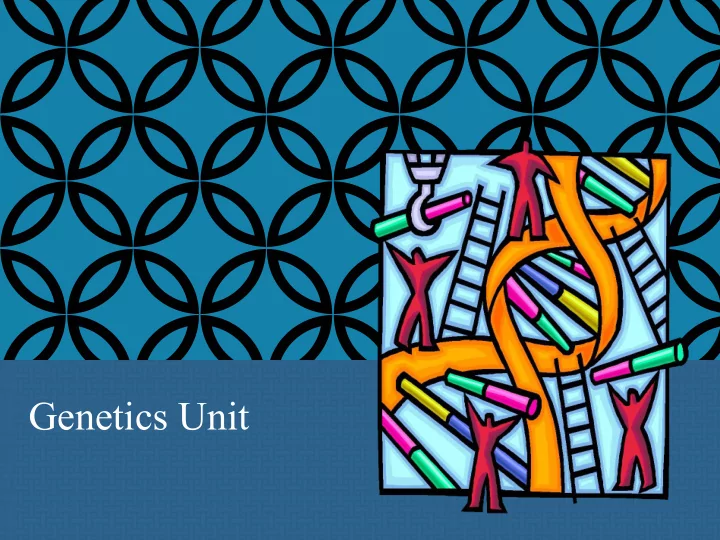

Genetics Unit
Lesson 2: How are Characteristics Inherited?
VOCAB 1-4 1) Genetics - the study of genes, heredity, and genetic variation in living organisms. 2) DNA (Deoxyribonucleic Acid) - carries the genetic information for a cell and is a set of instructions that tells the cell what to do or be. 3) Chromosome – a single long molecule of DNA (x shape). 4) Gene – a part of the chromosome that contains DNA.
VOCAB 5-8 5) Inherited trait – a characteristic passed from parents to their offspring. 6) Dominant trait – a strong trait that appears even if the organisms has only one factor. 7) Recessive trait – a trait that appears only if an organism has two factors. 8) Hidden trait – a trait that an organism carries, but is not expressed.
The Father of Genetics ➢ 19 th century Austrian monk Gregor Mendel ➢ His experiments with pea plants taught scientists how traits are passed from parents to their offspring A monk is a member of a religious community of men typically living under vows of poverty and obedience.
Punnett Square You can use a Punnett Square to predict the trait that offspring will show. Insta Lab! Toss 2 pennies 30 times and record how they land on your own Punnett Square Textbook pages 160-161
3 Types of Adaptations: Physical 1. Behavioral 2. Life processes 3. Study Jams – Animal Adaptations Textbook pages 162-163
Adaptations, Migration, Extinction ➢ Adaptations are inherited traits that help living things meet basic needs and survive in their environments. ➢ Migration is an inherited trait that causes some animals to move to different places in order to survive. ➢ Extinction is the death of all organisms of a species. BrainPop Extinction
Bat Adaptations
Polar Bear Adaptations
Genes • DNA (Deoxyribonucleic Acid) is the chemical code that gives you your inherited traits like hair color, eye color, height, handedness and tongue rolling • Humans have 46 pairs of chromosomes or 23 pairs of a single long molecule of DNA (x shape). Textbook pages 166-167
Lesson 3: What Other Factors Affect Characteristics? Pages 168-176 in textbook
VOCAB 9-12 9) Heredity - the passing on of traits from parents to a child 10) Instinct – a behavior that an organism inherits 11) Learned (or acquired) behavior – a behavior that an animal acquires through experience 12) Environment – all the living and nonliving things that surround and affect an organism.
Investigate ➢ Draw the chart on textbook page 170 ➢ Decide if each behavior is a learned or inherited behavior. Remember our 2 vocabulary words: Instinct – a behavior that an organism inherits Learned (or acquired) behavior – a behavior that an animal acquires through experience Textbook pages 170-171
WHAT IS HEREDITY? Heredity - the passing on of traits from parents to a child ❖ We inherit traits from our parents What traits have your inherited from your parents? 1. Why do brothers and sisters resemble each other? 2. BrainPop Heredity 2:49
Inherited vs Learned Traits 1. Work with a partner to fill out #1-18 2. check your answers with the class 3. Fill out the Inherited/Acquired Traits flappable in your journals
Examples of Inherited traits
Inherited Traits: • Traits are characteristics we inherit from your parents. • The environment we grow up and live in also helps define our traits. ✓ For example: exposure to chemicals or sunlight can change hair color
Instincts Instinct is a behavior that an organism inherits. Journal Prompt: What effect do instincts have on an animal’s survival? https://app.discoveryeducation.com/learn/video s/d64db623-ad07-4da3-9904-253300a0d2d8 Brainpop: Behavior 3:04 Textbook pages 172-173
Learned Behaviors an animal acquires these behaviors through experience. Learned behaviors are ACQUIRED (learned or developed) Examples of Learned behaviors: • Cheetahs learn hunting skills • Toddlers learn how to walk and talk • Children learn how to use a spoon & fork • Parrots learn how to mimic humans https://app.discoveryeducation.com/learn/videos/340a5e95-c68a- 4e54-9571-0e4777986912 Textbook pages 174-175
Environmental Influences ➢ Some changes in environments force animals to change their behavior or may cause a physical change ▪ If food is less available, animals learn to eat different food or move to another area ▪ Pollution and poison can damage chromosomes that affect offspring causing defects Textbook pages 176-178
Genetic mutations occur when there are changes in a cell’s DNA. Albinism – loss of pigmentation in the skin, hair, and eyes Bill Nye Genetics
Smallest Woman in the World https://brainpop genetic mutations/
How Rare Are Four Leaf Clovers? The Secret of the Four Leaf Clover 1:40
Famous DNA Scientists: Rosalind Franklin Rosalind Franklin: an English scientist who made the first x-ray images of DNA DNA X-ray
discovery/history Maurice Wilkins gives Franklin’s x-rays to 1950’s -1960’s Watson and Crick Maurice Wilkins Francis Crick and James Watson make a model of DNA
Watson and Crick - Franklin dies of cancer - Wilkins, Watson, and Crick share a Nobel Prize for the DNA model
Recommend
More recommend